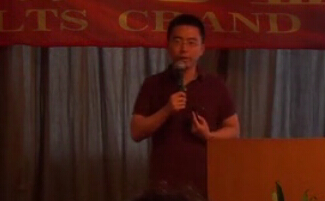雅思考试阅读精选训练题(5)
2013-07-29 14:08 供稿单位: 新航道
出国英语考试有哪些 雅思6.5是什么水平 雅思阅读评分标准 托福阅读评分标准 雅思和托福的区别
★Don't wash those fossils!
Standard museum practice can wash away DNA.
1. Washing, brushing and varnishing fossils — all standard conservation treatments used by many fossil hunters and museum curators alike — vastly reduces the chances of recovering ancient DNA.
2. Instead, excavators should be handling at least some of their bounty with gloves, and freezing samples as they are found, dirt and all, concludes a paper in the Proceedings of the National Academy of Sciences today.
3. Although many palaeontologists know anecdotally that this is the best way to up the odds of extracting good DNA, Eva-Maria Geigl of the Jacques Monod Institute in Paris, France, and her colleagues have now shown just how important conservation practices can be. This information, they say, needs to be hammered home among the people who are actually out in the field digging up bones.
4. Geigl and her colleagues looked at 3,200-year-old fossil bones belonging to a single individual of an extinct cattle species, called an aurochs. The fossils were dug up at a site in France at two different times — either in 1947, and stored in a museum collection, or in 2004, and conserved in sterile conditions at -20 oC.
5. The team's attempts to extract DNA from the 1947 bones all failed. The newly excavated fossils, however, all yielded DNA.
6. Because the bones had been buried for the same amount of time, and in the same conditions, the conservation method had to be to blame says Geigl. "As much DNA was degraded in these 57 years as in the 3,200 years before," she says.
Wash in, wash out
7. Because many palaeontologists base their work on the shape of fossils alone, their methods of conservation are not designed to preserve DNA, Geigl explains.
8. The biggest problem is how they are cleaned. Fossils are often washed together on-site in a large bath, which can allow water — and contaminants in the form of contemporary DNA — to permeate into the porous bones. "Not only is the authentic DNA getting washed out, but contamination is getting washed in," says Geigl.
9. Most ancient DNA specialists know this already, says Hendrik Poinar, an evolutionary geneticist at McMaster University in Ontario, Canada. But that doesn't mean that best practice has become widespread among those who actually find the fossils.
10. Getting hold of fossils that have been preserved with their DNA in mind relies on close relationships between lab-based geneticists and the excavators, says palaeogeneticist Svante P bo of the Max Planck Institute for Evolutionary Anthropology in Leipzig, Germany. And that only occurs in exceptional cases, he says.
11. P bo's team, which has been sequencing Neanderthal DNA, continually faces these problems. "When you want to study ancient human and Neanderthal remains, there's a big issue of contamination with contemporary human DNA," he says.
12. This doesn't mean that all museum specimens are fatally flawed, notes P bo. The Neanderthal fossils that were recently sequenced in his own lab, for example, had been part of a museum collection treated in the traditional way. But P bo is keen to see samples of fossils from every major find preserved in line with Geigl's recommendations — just in case.
Warm and wet
13. Geigl herself believes that, with cooperation between bench and field researchers, preserving fossils properly could open up avenues of discovery that have long been assumed closed.
14. Much human cultural development took place in temperate regions. DNA does not survive well in warm environments in the first place, and can vanish when fossils are washed and treated. For this reason, Geigl says, most ancient DNA studies have been done on permafrost samples, such as the woolly mammoth, or on remains sheltered from the elements in cold caves — including cave bear and Neanderthal fossils.
15. Better conservation methods, and a focus on fresh fossils, could boost DNA extraction from more delicate specimens, says Geigl. And that could shed more light on the story of human evolution.
(640 words nature )
Glossary
Palaeontologists 古生物学家
Aurochs 欧洲野牛
Neanderthal (人类学)尼安德特人,旧石器时代的古人类。
Permafrost (地理)永冻层
以上就是新航道雅思频道为大家整理的雅思考试阅读精选训练题(5),希望对大家有帮助,更多资讯、资料请访问新航雅思写作频道 https://www.xhd.cn/ielts/yucezhenti/
- 上一篇:雅思考试阅读精选训练题(6)
- 下一篇:雅思考试阅读精选训练题(4)
分享到:

- 新航道,英语成功之道。时间获取新航道英语学习资料和新鲜资讯,请在微信公众账号中搜索「新航道英语」或者「xhdenglish」,或用手机扫描左方二维码,即可获得新航道每日精华内容推送和英语学习经验分享,并参与新航道举办的各项活动。
责编:李术
精彩专题
更多视频荟萃
更多
-
新航道姚骏鹏-雅思阅读高分攻略
时长:03-06

-
新航道陈侃侃-雅思口语要有范儿
时长:03-06

-
【3分钟学雅思】王大锤告诉你为啥药不能停
时长:01-12

-
【3分钟学雅思】全世界个感官餐厅
时长:01-12
热门文章
更多
-
8月31日雅思广州考机考初体验
选择机考模式的考生将通过机考模式参加听...








